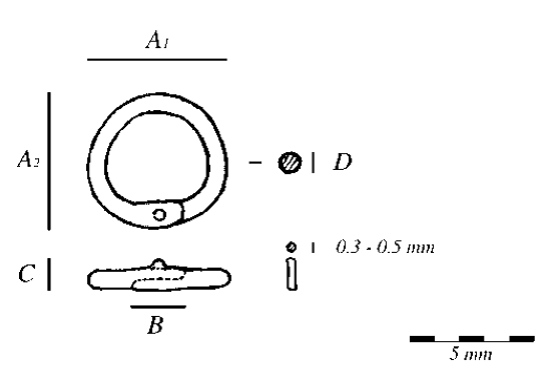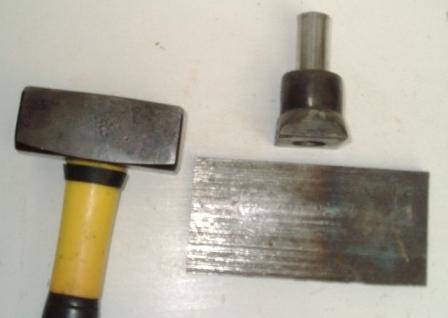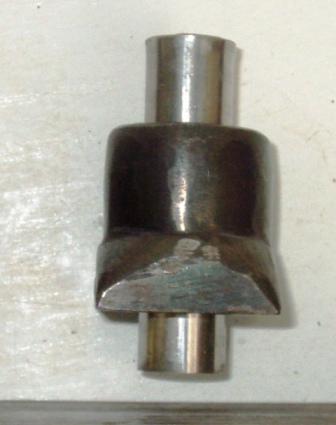| Author |
Message |
Thomas R-W

Location: Minnesota, USA Joined: 15 Aug 2014
Posts: 27
|
 Posted: Sun 13 Dec, 2015 7:36 am Post subject: What gauge steel wire is best for flat ring riveted mail? Posted: Sun 13 Dec, 2015 7:36 am Post subject: What gauge steel wire is best for flat ring riveted mail? |
 |
|
I've been looking into buying steel wire to make my own rings for a riveted mail shirt but I'm not sure what gauge would be best to make the flattened rings the most historically accurate thickness. Also could anyone point me to cheap rivets for it? It would be highly appreciated.
~Thorill
|
|
  |
 |
|
Mart Shearer
|
 Posted: Sun 13 Dec, 2015 8:06 am Post subject: Posted: Sun 13 Dec, 2015 8:06 am Post subject: |
 |
|
Historically accurate thickness varies between approximately 20 g (c. 0.5mm) and 12g (c. 3.3mm). What is "best" depends on the criteria you use. Ring diameter and historical timeframe might be factors to consider as well. Historically, rivets are made from wire or slit sheet.
ferrum ferro acuitur et homo exacuit faciem amici sui
|
|
  |
 |
Thomas R-W

Location: Minnesota, USA Joined: 15 Aug 2014
Posts: 27
|
 Posted: Sun 13 Dec, 2015 9:39 am Post subject: Posted: Sun 13 Dec, 2015 9:39 am Post subject: |
 |
|
| Mart Shearer wrote: | | Ring diameter and historical timeframe might be factors to consider as well. Historically, rivets are made from wire or slit sheet. |
I'm trying to make something that would be close to viking age, possibly a little later but around there. And for rivets would it work just to snip bits of the wire I'm using to make the rings and put that through a hole as a rivet or should I buy rivets separate do you think?
~Thorill
|
|
  |
 |
|
Julio Junco
|
 Posted: Sun 13 Dec, 2015 10:46 am Post subject: Posted: Sun 13 Dec, 2015 10:46 am Post subject: |
 |
|
You can use wire with 1.3 mm diameter. It is easier to handle and easy to pierce.
If your mail will be Viking Ages perhaps would be better round section rings . The rivet can be round wire but smaller, 0.6 mm in diameter or slightly larger, not more than 0.8 mm.
If you want wedge rivet, you can use metal strips 0.6 mm thick and cut wedges about 3 mm long. But for Viking Ages, better round rivet.
Regards
Julio
|
|
  |
 |
Thomas R-W

Location: Minnesota, USA Joined: 15 Aug 2014
Posts: 27
|
 Posted: Sun 13 Dec, 2015 10:58 am Post subject: Posted: Sun 13 Dec, 2015 10:58 am Post subject: |
 |
|
| Julio Junco wrote: | | If your mail will be Viking Ages perhaps would be better round section rings . |
I like the flat ring look a bit better, that's the only reason I'm going with that but I thank you for your information. So 16 gauge for the rings and about 20-22 gauge for the rivets would be best you say? Also if you could answer me one more thing. Is an internal diameter of 6mm or 8mm best for this type of mail?
~Thorill
|
|
  |
 |
|
Julio Junco
|
 Posted: Sun 13 Dec, 2015 11:55 am Post subject: Posted: Sun 13 Dec, 2015 11:55 am Post subject: |
 |
|
I know it only in mm but I think is ok.
You can roll the wire in a 7 mm mandrel and when you do the overlap the ring go smaller than 7 mm innternal diameter. Nice and more dense but more work. And the Viking Ages mails can be bigger than 8 mm.
I put photos with 7 mm ID and 8 mm ID so you can see how it looks. The wire look the same 1'3 or 1'5 mm, only more resistent withh thick wire.
Julio
 Attachment: 325.31 KB Attachment: 325.31 KB
[ Download ]
 Attachment: 179.07 KB Attachment: 179.07 KB
[ Download ]
|
|
  |
 |
|
Mart Shearer
|
 Posted: Sun 13 Dec, 2015 2:13 pm Post subject: Posted: Sun 13 Dec, 2015 2:13 pm Post subject: |
 |
|
This chart may be of use.
http://www.vikingsonline.org.uk/resources/authenticity/chainmail/
You really should avoid flattened rings based on that evidence, as well as wedge rivets which don't appear until c.1300, acoording to our best current information.
ferrum ferro acuitur et homo exacuit faciem amici sui
|
|
  |
 |
Thomas R-W

Location: Minnesota, USA Joined: 15 Aug 2014
Posts: 27
|
 Posted: Sun 13 Dec, 2015 4:38 pm Post subject: Posted: Sun 13 Dec, 2015 4:38 pm Post subject: |
 |
|
| Mart Shearer wrote: | | You really should avoid flattened rings based on that evidence. |
You bring a fair point, but I do have a question on the terminology of the site. What does it mean by "lapped & riveted".
~Thorill
|
|
  |
 |
|
Mart Shearer
|
 Posted: Sun 13 Dec, 2015 6:35 pm Post subject: Posted: Sun 13 Dec, 2015 6:35 pm Post subject: |
 |
|
| Thomas R-W wrote: | | Mart Shearer wrote: | | You really should avoid flattened rings based on that evidence. |
You bring a fair point, but I do have a question on the terminology of the site. What does it mean by "lapped & riveted". |
The overlapping ends of the wire coil are riveted together. See Vegard Vike's article.
http://www.erikds.com/pdf/tmrs_pdf_11.pdf
 Attachment: 18.43 KB Attachment: 18.43 KB

Vegard Vike
ferrum ferro acuitur et homo exacuit faciem amici sui
|
|
  |
 |
Thomas R-W

Location: Minnesota, USA Joined: 15 Aug 2014
Posts: 27
|
 Posted: Sun 13 Dec, 2015 7:11 pm Post subject: Posted: Sun 13 Dec, 2015 7:11 pm Post subject: |
 |
|
| Mart Shearer wrote: | | The overlapping ends of the wire coil are riveted together. |
Ah alright that was a pretty stupid question now that I think about it. Would you have any suggestions as to how I can effectively flatten only the area I want to rivet? Since the rings are so small it's much harder to only flatten one area. Thanks for all your help and in advance for any more you may give me.
~Thorill
|
|
  |
 |
Dan Howard

|
 Posted: Sun 13 Dec, 2015 7:41 pm Post subject: Posted: Sun 13 Dec, 2015 7:41 pm Post subject: |
 |
|
With some practice you can do it with a ball-pein hammer.
Author: Bronze Age Military Equipment, Pen and Sword Books
|
|
  |
 |
Thomas R-W

Location: Minnesota, USA Joined: 15 Aug 2014
Posts: 27
|
 Posted: Sun 13 Dec, 2015 7:53 pm Post subject: Posted: Sun 13 Dec, 2015 7:53 pm Post subject: |
 |
|
| Dan Howard wrote: | | With some practice you can do it with a ball-pein hammer. |
Would a 2 pound sledge work?
~Thorill
|
|
  |
 |
Dan Howard

|
 Posted: Sun 13 Dec, 2015 11:11 pm Post subject: Posted: Sun 13 Dec, 2015 11:11 pm Post subject: |
 |
|
Not really. It might work on really large links but that is about all.
Author: Bronze Age Military Equipment, Pen and Sword Books
|
|
  |
 |
Thomas R-W

Location: Minnesota, USA Joined: 15 Aug 2014
Posts: 27
|
 Posted: Sun 13 Dec, 2015 11:21 pm Post subject: Posted: Sun 13 Dec, 2015 11:21 pm Post subject: |
 |
|
So I'll just need a bit smaller hammer?
~Thorill
|
|
  |
 |
Dan Howard

|
 Posted: Mon 14 Dec, 2015 3:45 am Post subject: Posted: Mon 14 Dec, 2015 3:45 am Post subject: |
 |
|
Ball pein
Author: Bronze Age Military Equipment, Pen and Sword Books
|
|
  |
 |
Thomas R-W

Location: Minnesota, USA Joined: 15 Aug 2014
Posts: 27
|
 Posted: Mon 14 Dec, 2015 5:13 am Post subject: Posted: Mon 14 Dec, 2015 5:13 am Post subject: |
 |
|
Alright what is it about ball-peen hammers that makes them the best tool for this?
~Thorill
|
|
  |
 |
|
Julio Junco
|
 Posted: Mon 14 Dec, 2015 11:10 am Post subject: Posted: Mon 14 Dec, 2015 11:10 am Post subject: |
 |
|
If I use ball peen hammer for this, I destroy a lot of rings. Maybe I´m not skilled
I use metal rod ( was made by Pekka Passanen from Finland) and a good hammer.
I cut the rings, make the overlap and then small blow with the hammer and the steel rod so I flatten the overlap area only. Look the photos.
Very useful information in maille/info" target="_blank">https://groups.yahoo.com/neo/groups/rivetedmaille/info
Regards
Julio
 Attachment: 6.49 KB Attachment: 6.49 KB

 Attachment: 20.97 KB Attachment: 20.97 KB

 Attachment: 23.54 KB Attachment: 23.54 KB

|
|
  |
 |
Dan Howard

|
 Posted: Mon 14 Dec, 2015 12:41 pm Post subject: Posted: Mon 14 Dec, 2015 12:41 pm Post subject: |
 |
|
Yes you will destroy a lot of rings untill you get used to the technique. If you don't practice with the hammer and instead use a fancy tool then how can you expect to get skilled?
Author: Bronze Age Military Equipment, Pen and Sword Books
|
|
  |
 |
|
Julio Junco
|
 Posted: Mon 14 Dec, 2015 1:19 pm Post subject: Posted: Mon 14 Dec, 2015 1:19 pm Post subject: |
 |
|
A small steel bar is fancy tool? Amazing.You only need a little steel bar, not "fancy tool"
It´s cheap, easy and fast.
You need to make right the overlap and ring softening, like if you use the ball peen hammer . But it works better. Of course I used other methods before 
Julio
|
|
  |
 |
|
|

